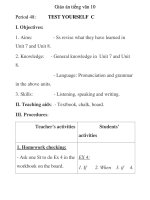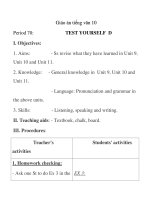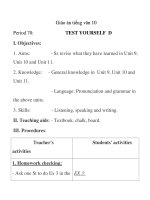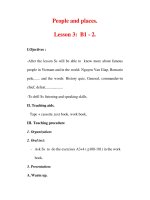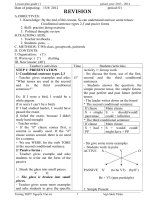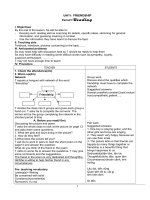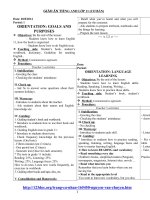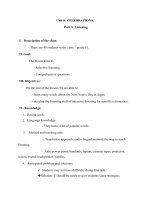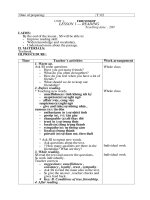giáo án tiếng anh lớp 11
Bạn đang xem bản rút gọn của tài liệu. Xem và tải ngay bản đầy đủ của tài liệu tại đây (962.27 KB, 124 trang )
Unit1: Friendship
Period1 Reading
I. Objectives
By the end of the lesson, Ss will be able to:
- Develop such reading skill as scanning for details, specific ideas, skimming for general
information, and guessing meaning in context
- Use the information they have learnt to discuss the topic
II. Teaching aids
Textbook, handouts, pictures concerning to the topic
III. Anticipated problems
Ss may need help with discussion task so T should be ready to help them
Ss may have difficulty in reading some difficult words such as:sympathy, loyalty,
suspicion,enthusiasm .
T may not have enough time to teach
IV. Procedure
teacher students
1. Check the attendance(2m)
2. Warm up(4m)
Network
T repairs a hangout with network of the word
friendship
T divides the class into 8 groups and gives each group a
hand out. T asks Ss to complete the net work. The
winner will be the group completing the network in the
shortest period of time
A. Before you read(10m)
Discussing the picture and poem
T asks the whole class to look at the picture on page 12
and asks them some questions:
1. What are girls and boys doing in the picture?
2. How do they feel?
3.What does the picture tell you?
T ask Ss to work in pairs to read the short poem on the
page13 and answer the question:
What do you think of the friend in the poem
T calls on some Ss to answer the questions. T may give
some comments and the suggestions:
The friend in the poem is very dedicated and thoughtful.
He/She is willing to help his/her friend in any
circumstances
Pre- teaching vocabulary
Lasting(a)= lifelong
Be concerned with sb/st
Constancy(n)constant(a)
Rumour(n) ['ru:m]
Group work
Discuss about the qualities which
friendship must have to complete the
network
Suggested answers:
Honest,unselfish,constant,loyal,mutual
trust,sympathetic,patient
Pair work
Suggested answers
1. One boy is playing guitar, and the
other girls and boys are singing
2. They seem very happy because we
can see their smile
3. The picture tells us that friends can
happily do many things together or
friendship is a beautiful thing that
brings happiness to us
Dedicated(a)tận tâm, tận lực
Thoughtful(a)chu đáo, quan tâm
Circumstance(n)hoàn cảnh, tình
huống
Lâu dài, bền vững
Quan tâm tới ai, cái gì
tính kiên định
tin đồn
1
Friendship
Gossip(n): information talk or stories about other
people s private lives that may be unkind or not true
Incapable of/ in'keipbl/
Suspicion(n)/ s'spin/ suspicious(a)
Pursuit(n)
Sympathy(n) ['simpi], sympathetic(a)[,simp'etik/
Sorrow(n)/ 'srou/= sadness
T asks Ss to make some Ss to make sentences with
above words to check their understanding
Have Ss practice reading the vocabulary
B. While you read
Setting the scence
You are going to read a passage about the qualities of a
long lasting friendship. While you reading, do the task in
the textbook
Task1 (6m)
T asks the Ss to read the words in the box then fill each
blank with one of them
Ask Ss to read the passage quickly and stop the lines
that contain these words to guess their meaning
T asks Ss to work individually to do the task
T goes around to help them when necessary
T asks Ss to exchange their answers with the other Ss
T asks Ss for their answers and tell then to explain their
choices
Task 2(5m)
T asks Ss to read the passage again and decide which
of the choices A,B,C,or D most adequately sum up the
ideas of the whole passage
T gets Ss do the task individually
T might also want to give Ss some strategies to find the
main idea of the passage
T calls on some Ss to give the answer and asks other Ss
to say whether they agree or disagree
Task 3(10m)
Ask Ss to answers the questions in task3
T asks Ss to do the task individually to do the task, then
discuss their answers with their partner
T calls some Ss to write their answers on the board and
ask them to explain their choices
Correct answers:
1. The first quality for true friendship is unselfishness. It
tells us that a person who is concerned only with his/her
own interest and feelings can t be a true friend
2. Because they take up and interest with enthusiasm,
but they are soon tired of it and they feel the attraction of
some new object
3. The third quality for true friendship is loyalty. It tells us
that the two friends must be loyal to each other, and they
must know each other so well that there can be no
suspicions between them
4. Because if not people can t feel safe when
telling the other their secret
5. Because they cannot keep a secret, either of their
own or of others
6. The last quality is sympathy. It tells us that to be a
true friend one must sympathise with his/her friend.
chuyện ngồi lê đôi mách, chuyện tầm
phào
không đủ khả năng
sự nghi ngờ
sự nghiệp, sự theo đuổi, đam mê
sự thông cảm
thông cảm, đồng cảm
nỗi buồn
do as T s requests
whole class
individual work & pair work
Ss guess the meaning of the word
base on the context in the sentences
1. mutual
2. incapable of
3. unselfish
4. acquaintance/ friend
5. give -and -take
6. loyal to
7. suspicious
Whole class read the text carefully
Individual work
Answer: B
Individual work and pair work
Pay attention then give remark
Correct themselves their mistakes
2
Where there is no mutual sympathy between friends,
there is no true friendship
C. After you read(6m)
Ask Ss to work in pairs to discuss the question in the
text book
T goes around to help the Ss when necessary
When all pairs have finished, T asks every two pairs to
share ideas
T calls on some Ss to report their ideas to the class
4. Homework(2m)
Learn by heart all of new words and structures and give
examples
Summarise the main points of the text
Pair work
The friendship is very important to our
life. A true friend can helps us when
we are sorrow and when we have
difficulty. We can share ideas, feeling,
likes,joys, pleasures,aims .to each …
other. Sometimes only true friends
can understand, sympathise us so we
feel safe to tell him/her our secrets.
Friendship brings us happiness. We
happily do many things together.So
we can t live without friendship’
Whole class
Period 2: Speaking
I. Objectives
By the end of the lesson Ss will be able to
Describe the physical characteristics and personalities of their friends, using appropriate adjectives
II. Teaching aids
Textbook, handouts, pictures about some famous people .…………
III. Anticipated problems
Ss may not have enough vocabulary to talk about the topic, so T should be ready to provide help
IV. Procedure
teacher students
1. Check the attendance(2m)
2. Warm up(5m)
Ask Ss to describe one of their friend or their relatives
3. New lesson
A. Presentation(10m)
Task 1
Ask 1 S to read aloud the title and explain
Instruction: You are going to look at the picture of 4
people on page 15 and describe them in pairs
Before letting Ss do the task, T ask them to read useful
language on page 16
T may explains some word if Ss don t know the ’
Do as teacher s request’
Pair work
Whole class
3
meaning of the adjectives provided
Forehead(n)/ 'f:hed/: T points at his/her forehead
Crooked(a)/ 'krukid/
T may ask Ss to provide some adjective/expressions
used to describe people Ss appearance. She may also
give Ss handout of these adjectives and expressions:
Height :tall,short, medium
Build : slim(mảnh khảnh), plump(bụ bẫm, đầy đặn),
overweight, thin.muscular/ 'mskjul/(vạm vỡ),
stocky(thấp và chắc), well-built(lực lỡng)
Hair:
-length: long, short, shoulder- length
-style: straight , wavy, curly,crew-cut(đầu cua)
-color: black,grey, red, brown
Others: a fringe(mái), a bun(búi tóc), plait(s)/ plổt/đuôi
sam
Face: oval, round, large, square, skinny/ ['skini](gầy
nhom,gầy trơ xơng), chubby(phúng phính), long, with high
cheekbones(gò má cao)
Eyes: small, big, black, brown, blue
Nose: straight, crooked, turned-up(hếch), big, small,
flat(tẹt)
Chin: pointed chin(cằm nhọn),double chin
Lips: thin, full, narrow, heart-shaped
Forehead: broad, high
Skin:white,pale/peil/(tái, xanh xám), suntanned(rám
nắng),dark, brown, black
General appearance:beautiful, handsome,pretty,good
looking, plain(bình thờng)
T asks to work in pairs to describe the people in the
picture, and then calls on some Ss to present their
answer
T gives feedback
B. Practice(10m)
Task 2
Ask Ss to discuss and number the personalities in
order of importance in friendship and then report the
results
Before Ss do the task, T asks them to look at the list of
adjectives provided in book. T asks if Ss understand
these adjectives or not
T can elicit [i'lisit](luận ra,gợi ra) or explain some
adjectives quickly
Caring
Hospitable
Modest
sincere
understanding
T divides the class into group of 6 with a group leader.
They discuss and the leader will take notes of the
ideas, and then one representative will report the result
to the whole class. T reminds Ss that they have to
explain their choice as well
T goes round to offer help when Ss discuss
T call on some Ss to report the result of their
Trán
Mũi khoằm
Whole class use hangouts to describe
1. The boy is about 16. He is short-
sighted because he s wearing apair of
glasses. He has short black hair, a
round face with a broad forehead, a
small nose,thin lips and small chin. He
quite good-looking
2.The girl is about 14. She s also
wearing a pair of glasses. She has
shoulder-length black hair, and she s
wearing a ribbon(bờm tóc). She has an
oval face with a straight nose, full lips
and a pointed chin. She quite pretty
3. The man is in his forties. He s tall
and well-buit. He has short brown hair
and a square face with a broad head,
small eyes , a crooked nose and thin
lips. He quite good looking
4. The woman is her twenties. She s
quite tall and slim. She has long curly
brown hair and an oval face with a
broad forehead, big eyes, a straight
nose heart-shaped lips and a small
chin. She s very beautiful
Whole class and group work
Chu đáo
Hiếu khách
Khiêm tốn
Chân thành
Thông cảm, thông hiểu
Group work
1
st
group: My group thinks that being
caring is the most important in
friendship because when friends care
about eachother, they will know when
to share happiness or difficulty with
their friend
4
discussion.
T elicits feedback from the class and gives final
comments
C. Production(15m)
Task 3
Instruction: Imagine that you have a friend who has
just won the first prize in Mathematics. A journalist is
going to interview you about your friend. Act out the
interview in pairs
T asks Ss to look at their role on page 16 anf the
suggestions on page 17
T may elicit the questions they may ask
-his /her hobbies: What does he/she like doing in
his/her freetime?what are his/her hobbies
-his/her physical characteristics: what does he/ she
look like?
His/her personalities:How is he/she?Is she/he
friendly ?
T may also make clear the meaning of some adjectives
Quick-witted
Good-natured
T asks Ss to work in pairs to perform the interview in 7
minutes and goes around to offer help
T call on some pairs to perform the interview
T elicits feedback from the class and gives final
comments
4. Home work(3m)
Write down a paragraph to describe your best friend
Prepare the next period listening” ”
Pay attention
Nhanh trÝ
Tèt bông
Pair work
Whole class
Period 3 Listening
I. Objectives
By the end of the lesson Ss will be able to
Develop such listening micro-skills as intensive listening for specific information and taking notes
while listening
II. Teaching aids
Textbook, handouts, cassette tapes .…………
III. Anticipated problems
Ss may not be familiar with the note-taking task,so T should provide them some tips to deal with the
task
IV. Procedure
teacher student
1. Check the attendance(2m)
2. Warm up(5m)
Whole class
5
Matching
The aim of this activities is to help Ss revise the
vocabulary items Ss learnt in the previous lesson
T divides the class into small groups of 3-4 students
Then T distributes the following crossword hand out for
Ss to do in their own groups. Which group finishes first
and has all the correct answers will be the winner
A B
1. good-natured a,Nhanh trí
2. friendly b, Hào phóng
3. quick-witted c, Hiếu khách
4.hospitable d, Hay giúp đỡ
5. patient e,Khiêm tốn
6. honest f, Ham học
7. generous g, Kiên nhẫn
8. helpful h,Thật thà
9. modest i, Thân thiện
10. studious j, Tốt bụng
3. New lesson
A. Before you listen(10m)
Talking about your best friend
- T asks Ss to discuss the questions on page 17 in
pairs
- T calls on some Ss to give their answer and
comments on the answer
- T gets Ss what they are going to listen about
Vocabulary pre teaching
- Before teaching the new words, T helps Ss to
pronounce the words given in the book. T may read
aloud first or play the tape and ask Ss to repeat in
chorus and individually
- elicits/teaches some of these word and those taken
from the listening passage
Apartment building:
Sense of humour:
Give sb a ring: phone sb
Go though a rough time:
- T may get Ss to make sentences with the words and
give corrective feedback
B.While you listen
Task 1(10m)
Instruction: You are going to listen to Lan and Long talk
about their best friends. Listen and decide whether the
statements are True or False. Put a tick() in the
appropriate box
Before Ss listen and do the task, T instructs them to use
some strategies
+ First, read through the statements to understand them
and underline key words. For example, the key words in
the first statement are: shared, Nguyen Cong
Tru, Residential Area, Hanoi
+ Listen to the tape and pay attention to the key words
+ Decide whether statements are true or false based on
what they can hear
- T plays the tape once for Ss to do the task
- T asks for Ss answers and writes them on the board
- T plays the tape the second time for Ss to check
Group work
1. j
2. i
3. a
4. c
5. g
6. h
7. b
8. d
9. e
10. f
Pair work
Whole class
Toà nhà có nhiều căn hộ
Khiếu hài hớc
Gọi điện cho ai
Trải qua thời kỳ khó khăn
Pay attention
Individual work & Group work
Lans talk
1. F(They used to live in the same
buiding there)
2. F( It is what people think)
3. T
6
their answers
- T asks Ss to work in group 4 to compare their
answers
- T checks Ss answers by calling some Ss and asks ’
them to explain their answers
Task 2(7m)
Instruction: You are going to listen to the tape again and
fill the table in the book with notes
-T plays the tape again for Ss to complete their notes.
- after playing the tape, T gets Ss to work in pair and
check their answers
- T calls on some Ss to give the answers. T provides
correct answers if necessary. If Ss cannot comple the
task, T might let Ss listen one more time and pause at
the answers for them to catch
Suggested answers:
How and where did
they meet?
What do they like about
their friends?
Lan - They used to live in
the same apartment
building in HN
- Lan went on a
holiday in Do Son and
Ha went there to help
her
- Ha s very friendly and ’
helpful
- Ha Ss sociable. She s ’ ’
got many friends in Do
Son and she introduced
Lan around.
Long - They met in college
- Minh played the
guitar, and Long was a
singer
- They worked together
- Minh has a sense of
humour
- Minh likes to go to plays
and movies
- Minh is a good listener
- Minh is friendly and
helpful
C. After you listen(8m)
- T asks Ss to work in pairs to talk about how Ha has
been Lan s best friend and how Minh has been Long s ’ ’
best friend
- T goes around to offer help and correct Ss mistakes’
- T calls on some pairs to present their answers
- T elicits feedback from the class and give final
comments
4. Home work (3m)
Ask Ss to learn by heart all new words and prepare the
next lesson writing“ ”
4. F( Lan went to Do Son first and
then called Ha, so Ha rode on her
mortorbike to Do Son to meet Lan)
5. T
6. F( They have been best friends
since Lan s trip to Do Son)’
Long’s talk
1. F( They met in college)
2. F ( Minh was a guitarist)
3. T 4. T 5. T
Whole class
Individual work and then pair work
Listen to the tape carefully and fill
the table in the book with note
Pair work
Whole class
Tapescript:
Lan’s talk
My best friend is Ha. We ve been friends for a long time. We used to lived in Nguyen Cong Tru ’
Residential Area in HN. Her family moved to Hai Phong in1985. It is said that HP people are cold but
Ha is really, really friendly. I first started to get to know her when I was going on a two-day trip to Do
Son last year and didn t know anybody there. I gave Ha a ring and she was so friendly, she said. ’ “
Oh, I ll come to visit you . So she rode on her motorbike to Do Son and twenty minutes later she was’ ”
there. She stayed with me for two days. She happened to know a lot of people there, so she
introduced me around and we ve been best friends ever since.’
7
Long’s talk
My best friend is Minh. We met in college. And I was there singing and Minh was a guitarist. So we
worked together a lot, but we also became friends. Minh has a great sense of humour, he s very,very’
funny, and that s of my favourite things about him. And over the years, we have been through good ’
times and bad times with each other, and that s one of the things I like best about him. And we have ’
a lot of the same interests. We like to go to plays and movies together. But when we re going through ’
a rough time, he s really a good friend, and he s a very good listener, and he always helped me ’ ’
though.
Period 4: Writing
I. Objectives
By the end of the lesson Ss will be able to:
Write about a friend, real or imaginary, using the words and expressions that they have learnt in
previous lesson
II. Teaching aids
Textbook, handouts, .…………
III. Anticipated problems
Ss may not have sufficient vocabulary to write about the topic, so T should be ready to help them
IV. Procedure
Teacher Students
1. Check the attendance(1m)
2. Warm up(6m)
Guessing game
T introduces the game: 1 student goes to the board
and T gives him or her a piece of paper with the name
of a student in the class. Other Ss have to ask Yes/No
question to find out who students is. Ss should ask
about the appearance, personalities, or clothes .…
- The game can continue until the time is up.
A. Before writing(13m)
- T sets the scene: You are going to write about a
friend, real or imaginary, using the provided guidelines
- T gets Ss to read the task and the guidelines silently
and work out what they are required to write about. In
general, Ss writing should include 3 parts:’
+ general information about about their friend
+ his/her physical characteristics and personalities
+ and what Ss like about the friend
T elicits the verb tenses that may be useful when Ss
want to write about when and where they met their
friend. In this case, Ss may use the simple past tense
and past continuous in their writing.
T revises the use of the past tense and past continuous
tense
T may also elicit the adjectives and expressions Ss can
use to describe their friend s appearance and ’
personalities
T gets Ss prepare an outline for their writing and
exchange it with their peer(partner)\
T goes around to offer help and gives corrective
feedback
B. While writing(15m)
T gets Ss to write about their friend in 15minutes
Group work
Ss may ask questions such as:
Is the person a girl?
Is she tall?
Is she short- sighted?
Is she friendly?
…………
Whole class
Pay attention
8
T goes around to observe and offer help
C. Post writing(8m)
T ask Ss to exchange their writing with another Ss for
correction
T goes around and collects mistakes and errors
T collects some writings for quick feedback
T writes Ss typical errors on the board and elicits self ’
and peer correction. T provides correction only when
Ss are not able to correct the errors
Finally, T provide general comments on the writings
4. Home work(2m)
Ask Ss to improve their writing, taking into
consideration their best friends and T s suggestions ’ ’
and corrections
Ask them to prepare the next period: language focus‘ ”
Individual work
Pair work and whole class
Whole class
Period 5: Language focus
I. Objectives
By the end of the lesson Ss will be able to:
-Distinguish the sound /dʒ/ and /t∫/
- Pronounce the words and sentences containing these sounds correctly
- Use some structures containing infinitives with and without to appropriately
II. Teaching aids
Textbook, handouts, .…………
III. Anticipated problems
Ss may find it difficult to pronounce the two sounds, so T should prepare a lot of practice
IV. Procedure
Teacher Students
1. Warm up(3m)
Noughts and Crosses
Hospitable Honest Around face
Caring Sense of humour Friendly
Large Good-natured Pleasant
2. New lesson
A. Pronunciation(10m)
-Pronouncing the two sounds separately
-T models the two sound /dʒ/ and /t∫/ for few times
and explains the differences in producing them
/dʒ/: is a voiced palatal
Voiced=vocal cords vibrate while making this sound
Palatal= put your tongue behind your top teeth, push
Group work
-Listen attentively
-Tell the difference
©m vßm miÖng h÷u thanh
D©y thanh ©m rung lªn khi ph¸t ©m
Listen and take note
9
air as you drop your tongue away from the roof of
your mouth
/t∫/ is an unvoiced fricative palatal
Unvoiced- vocal cords do not vibrate while making
this sound
Fricative palatal = touch your tongue to the back of
your upper teeth and pull your tongue away as your
push air out of your mouth
T plays the tape once for Ss to hear
the works containing these two
sounds. Then T plays the tape again
and this time asks Ss to repeat after
the tape
Pronouncing words containing the sounds
-T reads the words in each column all at once
/dʒ/:jam, joke, January, dangerous,passenger, village
/t∫/:children, changeable, cheese, mutual, church ,
which
-T reads the words once again, each time with a word
in each column to help Ss distinguish the differences
between the sounds in the words
- T reads the words and asks Ss to repeat them
- T asks Ss to practice pronouncing the words in pairs
-T goes around providing help
- T asks some Ss to pronounce the words and give
correction if necessary
Practicing sentences containing the target sounds
- T reads the sentences and asks Ss underline the
words with the sound and write /dʒ/ and /t∫/ under
them
- T asks Ss to provide the sentences in pairs
-T goes around providing help
- T asks some Ss to read the sentences and gives
feedback
B. Grammar and Vocabulary
1. To infinitive (10m)
- T writes some sentences on the board and underline
the to+ infinitive
+ I have letters to write to my friends
+ I have some homework to do
+ Does he get anything to eat?
+ Have you got anything to say?
- T asks Ss to comment on the use of to + infinitives in
these examples. T reviews the form and use of to –
infinities in the example
- The infinitive can be placed after nouns/pronouns to
show how they can be used or what is to be done with
them
+ I have letters to write = I have letters that I must
write……
+ I have some homework to do= I have some
homework that I must do
+ Does he get anything to eat?= Does he get anything
that he can eat?
N/pro+to -infinitives
©m v« thanh: d©y thanh ©m kh«ng rung
lªn khi ph¸t ©m
©m vßm miÖng phô ©m x¸t
Repeat after the tape
-/dʒæm/, / dʒouk/, /dʒænjuəri/, /deindʒrəs/,
'pæsindʒə/, /vilidʒ/
-/ 't∫ildrən/,/
't∫eindʒəbl/,/t∫i:z/, /'mju:tjuəl/,/t∫ə:t∫/, /wit∫/
Practice reading
Practice reading the sentences which
contain 2 sounds
Pay attention
-Give their opinions
- In the examples above the infinitives
are used to replace relative clauses
Give more examles
Take notes
10
Ex: I need someone to take care of my children
to -infinitives + prepsitions
ex: I need someone to talk to my mother
Can I borrow your case to keep my records in?
Adj + to -infinitive
Too/ enough + to infinitive–
Practice
Exercise 1
Ask Ss to do exercise1 individually and then compare
their answers with another student
- T calls on some Ss to read aloud their answers
- T gives the correct answers
2. Infinitive without to(10m)
- after “make, let”+object +bare infinitive
- after verbs of perception such as: feel, hear, watch,
see, notice, observe, smell+object +bare infinitive
Ask Ss to give some examples
Listen and ask the other to comment
Practice
Exercise 2
-T asks Ss to do exercise 2 in pairs. Ss have to
rewrite the sentences by using the words given
-T asks them to compare answers with another pairs
-T calls on some Ss to go to the board to write their
answers
- T asks other Ss to feedback and gives correct
answers
Production(10m)
Extra exercise
Join these pairs of sentences
1. she crossed the road. I saw her
2. They sang a song. I heard them
3. He looked the door. I observed him
4. She drove off. I saw her
5. He was foolish. He left the firm
6. A pavement artist drew a portrait in crayons. I
watch him
7. We can t refuse their invitation. It would look rude’
8. I met you again. I was happy
9. The film was boring. I didn t watch it’
10. The woman is old. She can t drive a car’
3. Homework(2m)
Learn by heart all the knowledge they ve learnt and ’
I pleased to see you
Ex: The water is too hot to drink
He Ss old enoughto go to school’
Individual work
1. Who wants somethings to eat
2. I have some letters to write
3. I am delighted to hear the news
4. My mother has some shopping to do
5. You always have too much to talk
about
6. It s lovely to see you again’
7. It s too cold to go out’
8. I m happy to know that you have ’
passed the exams
Ex:Nothing can make him cry
I see her cook dinner(completed
action)
Notice:I see her cooking dinner(I see
she s cooking dinner)’
Pair work and then individual work
1. The police watched them get out of
the car
2. They let him write a letter to his wife
3. I heard them talk in the next room
4. The customs officer made him open
the briefcase
5. The boy saw the cat jump though the
window
6. Do you think the company will make
him pay some extra money?
7. I felt the animal move towards me
8. Do you think her parents will let her
go on a picnic?
Whole class
1. I saw her cross the road
2. I heard them sing a song
3. I observed him lock the door
4. I saw her drive off
5. He was foolish to leave the firm
6. I watched a pavement artist draw a
portrait in crayons
7. It would look rude to refuse their
invitation
8. I was happy to meet you again
9. The film was not interesting enough
for me to watch
10. The woman is too old to drive a car
11
practice them again at home
Prepare the next lesson:unit 2 : reading Whole class
Unit 2: Personal experiences
Period 1 Reading
I. Objectives
By the end of the lesson Ss will be able to:
- Develop such reading skills as scanning for details, specific ideas, skimming for general
information, and guessing meaning in context, identifying the sequence of events
- Use the information they have learnt to discuss the story
II. Teaching aids
Textbook, handouts, cassette .…………
III. Anticipated problems
Ss may need help with discussion task, so T should be ready to help them
IV. Procedure
Teacher Students
1. Check the attendance(2m)
2. Warm up(5m)
Ask Ss some questions and ask Ss to answer
- when was your last birthday?
- What did you do on that day?
- How did you feel on that day?
- What did your parents offer you?
3. New lesson
A. Before you read(5m)
-T introduce the pictures:
The six pictures describe the events in a story.
They re not in chronological order. Can you describe ’
what s happening in each of the picture’
- T suggests for the Ss by asking some questions:
+ What do you see in the 1
st
picture?
+ What do you think might be relationship between
the girl and the man?
+ What do you see on the table?
……………………………………….
Vocabulary
Floppy cotton hat
Wad of dollar notes
B. While you read
Set the scene: you are going to read a story in which
a girl s telling about her most embarrassing situation’
Task 1(10m)
-T asks Ss to reads the passage silently and do the
task1
-T writes the given words and phrases on the board:
To make a fuss
Sneaky(a)
Glanced (at)
Embarassing(a)
Whole class
Answer the questions
Whole class
A man and a young girl
May be they are family members
It s money’
Mò v¶I mÒm
TËp tiÒn
Pay attention
Read the passage in silently
Guess the meaning of the words
G©y ån µo, Çm Ü
lÐn lót
to look quickly at st/sb
making you feel nervous, ashamed, or
stupid: lóng tóng, xÊu hæ
someone you admire and adore
12
Idol(n)
- T asks Ss to go back to the passage to locate and
read around these words
- T checks that Ss understand all these words
correctly by calling on some Ss to tell the meaning of
the word in Vietnameses
- Then T asks Ss to go back to the task and study the
given sentences
- T asks them to fill the blank with the words/ phrases
in the box
- T checks the answer with whole class
Task 2(5m)
- T asks Ss to read the text silently again and then
with a peer work out the sequence of the pictures
given on page 22 again
- T calls on a student to give and explain his/ her
answer
Task 3 (10m)
- T checks if Ss can answer the comprehesions in
task3 without having to read the passage again. If Ss
can not, T gets them to read the questions carefully
and gives them some tips to do the task
- T gets Ss to check their answer with a peer
- T calls on some Ss to write their answers on the
board and asks them to explain their choices
C. After you read(6m)
Ask Ss to look at the last picture(c) and give
suggestions
+ How did the girl in the picture feel?
+ Why did she feel that way?
+ What did she do after that?
- T calls on the group to tell and explain their choice
- Then T asks Ss to summarise the main points of the
lesson
4. Homework(2m)
Summarises the main points of the lesson again
Learn by heart the new words and make sentences
with them
1. glanced
2. making a fuss
3. ambarassing
4. idols
5. sneaky
Individual work& pair work
1. picture d 2. picture b
3. picture f 4. picture e
5. picture a
6. picture c
Individual work then pair work
1. A floppy cotton hat
2. to buy the hat for herself
3. A wad of dollar notes that looked
like the ones her father had given
4. Because she didn t like to make a ’
fuss
5. She bought the hat with it
Group work
1.She felt surprised/ ambarassed
Because the money she took from the
boy s bag was not hers’
2. Perhaps the girl might want to tell
her father the truth and ask him for
help. Perhaps the girl could come to
the police station, tell the police the
truth and ask them for help
May be the girl could get on the same
bus the next day and look for the boy
to return him the money
Whole class
Whole class
Period 2 Speaking
I. Objectives
By the end of the lesson Ss will be able to:
- Identify structures that are used to talk about past experiences and their influences on
13
one s life’
- Practice the present perfect and past simple, structures with Make“ ”
- Use these structures to talk about a past experience and how it affects their life
II. Teaching aids
Textbook, handouts, .…………
III. Anticipated problems
Ss may have problem using present perfect and past simple when talking about the past
IV. Procedure
Teacher Students
1. Check the attendance(2m)
2. Warm up(5m)
Ask Ss some questions about their experiences
- Have you ever sung in the public?
+ When did you sing in the public?
+ How did you feel ?
+ How did the experience affect you?
- Have you ever failed the exam ?
- Have you ever got a bad mark?
………………………
3. New lesson
Task 1(10m)
- T introduces the task and gets Ss to do it individually
then compare the answer with a partner
- Call on some Ss to read out his/her answers
- T checks with the class and gives feedback
- T introduces the structures:
Make sb do smt/make sb+Adj
Ex: The flu makes me stay at home/ The flu makes
me tired
Task 2(15m)
- T introduces the task and ask Ss to work individually
then compare the answer with a partner
-Notice Ss some about how to use past simple and
present perfect simple
+ Present perfect: used with ever to ask about past “ ”
experience:Have you ever been to England?
+Past simple: used when one keeps asking about that
experience: When did you go there?Who did you go
with?
- After finishing T gets Ss to read the sample
conversation in pairs
- 0pen dialogue:
A Have you ever .?– …………
B Yes, English girl – ………… ……
A How .meet ?– …… ………
B walking along asked the –……… ………
way .started talking …… ……
A What talk .?– ……… ……
B Everythging .name, turtles .– ……… …… ………
A How affect ?– …… ………
B Well, more interested .– ……… ………
- Call some pair Ss to practice the D then give marks
Task 3(10)
- T introduces the task: using suggested questions on
page 26 to ask and answer the questions about their
Whole class
Answer the questions
Yes, I have
On Teacher s Day’
I was all in a tremble(run)
Since then I haven t been afaid of ’
singing in the pubic
……………………….
Individual work and pair work
1. d 2. c 3. a 4.b 5.e
Appreciate(v): Coi träng, ®¸nh gi¸ cao
To change your attitude to sb/st( Thay
®æi th¸I ®é cña b¹n ®èi víi ai hoÆc
®iÒu g× ®ã)
-Give more examples
Whole class
Take notes
1.b 2.d. 3.h 4.a 5.e 6.g 7.c
Pair work
Close the book and practice the open
dialogue
Pair work
Ex: be seriously ill“ ”
-what(what disease did you get)
14
past experiences
- T calls on some pairs to perform their conversations
in front of the class
4. Home work(3m)
Learn by heart the dialogue
-when(when did you fall)
-how(How did you get ill)
-go to hospital(Did you have to goto )
- how(How did the experience affect
you?)
15
Period 3 Listening
I. Objectives
By the end of the lesson Ss will be able to:
Develop such listening skills as listening for specific information and taking notes while listening
II. Teaching aids
Textbook, handouts,cassette tape .…………
III. Anticipated problems
Ss may not have sufficient vocabulary to talk about the topic, so T should be ready to assit them. Ss
may not also be familiar with the note-taking task so T should provide them some tips to deal with the
task
IV. Procedure
Teacher Students
1. Check the attendance(2m)
2. Warm up(5m)
Hangouts : Matching
Column A Column B
1. Fire fighter
2. Fire alarm
3. Fire door
4. Fire escape
5. Fire hydrant
6. Fire extinguisher
7. Smoke
8. Fire struck
a. A metal stair way outside to
help people get out of a building
on fire
b. A pipe that draws water for
putting out a fire
c. A person who fights fires
d. What comes out of a fire
e. A fire-resistant door that can be
closed to stop the spread of a fire
f. A large truck that carries
firefghters and equipment to the
side of a fire
g. A tube that contains special
chemicals for putting out fire
h. A bell that tells you a fire has
started
3. New lesson
A. Before you listen(10m)
-Ask Ss to describe what is happening in the picture
on page 27
+What can you see in the picture?
+What is happening?
+ Who are these people?
+ What is this woman doing?
……
Vocabulary
1.Memorable(a) 5.Gas stove(n)
2.Terrified(a) 6. Embrace(v)
3.Scream(v) 7.Escape(v)
4.Replace(v) 8.Protect(v)
- Ask Ss to practice the vocabulary in chorus. T helps
Ss to pronounce them correctly
B. While you listen
Task 1(10m)
-Asks Ss to read the statements to understand them
-Tplays the tapes once for Ss to listen and do the task
- Check the answer with the whole class
- T can play the tape again and pauses at the
answers for them to catch
Whole class
Group work
Answer
1. c
2.h
3.e
4.a
5.b
6.g
7.d
8.f
Whole class
-A fire
-A house is burning and fire- fighters
are trying to put out fire
- They are fire-fighters
- She is carring her daughter out of
the fire
1. ®¸ng nhí 5. bÕp ga
2. sî h·I 6. «m
3. thÐt, gµo 7. trèn tho¸t
4. thay thÕ 8. b¶o vÖ
Practice reading
Whole class
Individual work
1. T 2. F(13 years ago) 3.F(in the
kitchen) 4. F(she was sleeping) 5. T
16
Task 2(10m)
-Ask Ss to study the text carefully for the missing
information they need to fill and guess the answers
- After playing the tape, T gets Ss to work in pairs and
check their answers
- Call on some Ss to give the answers
C. After you listen(6m)
-Before getting Ss to discuss, T teaches them some
useful expression of asking for and giving opinions:
-Asking for opinions:
+ What do you think about ?………
+ What s your opinion about ?’ …
+ What s your feeling about ?’ ………
+ What s your point of view about .?’ ……
+ How do you feel about ?…
+ Do you have any opinion about ?…
Expressing
opinions
Expressing
agreement
Expressing
disagreement
I think…
Personally, …
I believe .……
I feel…
In my opinion
From my point
of view
I agree
I think so, too
That s true ’
and…
That s right, ’
and .…
Well,may be,
but…
That might be
true, but …
Well, my feeling
is that
Well, I don t ’
think so. I think.
-Give some suggestions by asking some questions:
+Why does Christina think family is more important
than things?
+ Where do you get love/care from, Your family or
things?
+Can we buy new clothes?
+ Can you get new parents or brothers or sisters?
4. Homework(2m)
-Do the exercises in unit 2 in the workbook
-Prepare for writing lesson
Individual work and pair work
1.small 3. family 5. took
2.everything 4.replaced 6.appreciate
Group work
Take notes
Giving opinion
Because she has realized that she
needs her family. Things can be
replaced, but family can t’
From family
Yes, we can
No, we can t’
Whole class
Tapescript
Interviewer: This is Radio 3. In our Unforgettable Experiences programme tonight we talk to “ ”
Christina, a successful businesswoman. Hello Christina, welcome to our program
Christina: Hello and thank you! It s nice being with you tonight’
Interviewer: Christina, could you tell our audience about the most memorable experience
in your life?
Christina: Well, my most unforgettable experience happened thirteen years ago, when my house
burned down
Christina: The fire started in the kitchen where I forgot to turn off the gas stove
Interviewer: What were you doing at that time?
Christina: I was sleeping when I was suddenly woken up by terrible heat. I opened my eyes
to find out myself surrounded by walls of fire
Interviewer: That s terrible. How did you escape?’
Christina: I was terrified. Then I heard my mother s voice calling my name. I rushed to her. She ’
17
carried me out. Luckily, I got away without even a minor burn
Interviewer: Not many people are so lucky. Did the fire affect you in any way ?
Christina: Oh,yes. Yes, very much, in fact. Although I lost many things in the fire, the experience
helped me grow up
Interviewer: What do you mean?
Christina: Well, before the fire I was selfish. I always complained to my mother about how small
my room was or how few clothes I had. Then the fire came and destroyed everything
owned. But I slowly began to realized that I didn t really need my old things. I just ’
needed my family. After all, you can get new clothes anytime, but a family can never
be replaced
Interviewer: I see, so the fire took many things from you, but it gave you something too.
Christina: Exactly, It taught me to appreciate my family more than things
Period 4 writing
I. Objectives
By the end of the lesson Ss will be able to:
Write a personal letter telling about a past experience, using the structures and vocabulary that they
have learnt in previous lessons
II. Teaching aids
Textbook, handouts, .…………
III. Anticipated problems
Ss may not have enough vocabulary to write about the topic, so T should be ready to help them
IV. Procedure
Teacher Students
1. Check the attendance(2m)
2. Warm up(8m)
Brain-storming
-T asks Ss to tell about their unforgettable past
experiences and the others make questions to ask
-Which team makes more questions is the winner
A. Preparing to write(10m)
-T gets Ss to read the task
- Call on a S to answer and elicits more ideas
Most unforgettable experience
+what happened?
+ when it happened?
+Where it happened?
+ How it happened?
+who was involved?
+ How it affected you?
- T gets Ss to plan their stories according to the
questions
Writing(17m)
-T gets Ss to write their own letters in 10 minutes
-Then T asks Ss to work in pairs, exchange their
letters and correct each other
- T goes around the class to offer help
Feed back on Ss’ writing(6m)
-T chooses one letter and reads it to the class
Whole class
Group work
Past experiences:
-Failing an exam
-Getting a reward
……………………….
Whole class
-I nearly drowned
-A year ago, my last summer vacation
-A river near my grandparent s house’
-When I was swimming, I suddenly
caught a cold, I felt dizzy and I was
too weak to swim
-Some of my friends were also
swimming at that time, one tried to
save me
-I learned that life is so important
Individual work and pair work
Whole class
18
- T elicits corrective feedback from the class and gives
final comments afterwards.
3. Homework(2m)
Do exercise in work book
Prepare the next lesson
Period 5 Language focus
I. Objectives
By the end of the lesson Ss will be able to:
Distinguish the sounds /m /, /n / and / η /
Pronounce the words and sentences containing these sound correctly
Distinguish the uses of different verb tenses: present simple for indicating the past, past simple,past
continuous and past perfect
Use these verb tenses to solve communicate task
II. Teaching aids
Textbook, handouts, .…………
III. Anticipated problems
Ss might have difficulty distinguish and using different verb tenses correctly. Therefore, T should be
ready to assist them
IV. Procedure
Teacher Students
1. Check the attendance(2m)
2. Warm up(5m)
Underline the most suitable verb form in each
sentences
a. While Tom watched/was watching TV, there was a
power cut
b. Who drove/was driving the car at the time of the
accident?
c. By the time she got back, he had gone/went home
d. David had eaten/ate Chinese food before, so he
knew what to order
e. I did/ was doing some shopping yesterday when I
saw your friend
f. Laura missed the party because no one was telling/
had told her about it
Pronunciation(7m)
/m / : close the lips when pronouncing
/n / : Ss tongues touch the roof of their mouth’
/ η /: their tongues touch their soft palates
For all three sounds, the air goes through the nose
- T asks Ss to read the words in each column out loud
in chorus for a few more times. Then call on some Ss
to read the words out loud
- In order to help Ss identify these sounds T writes
some sentences to check their understanding
1. I ll call them/then’
2. He ran/rang twice
3. That bun/bum is delicious /di'li∫əs/
4. We got some/sun at the beach
- Practising sentences containing the target sounds
Ask Ss to work in pairs and take turn to read aloud
the given sentences
a. was watching
b. was driving
c. had gone
d. had eaten
e. was doing
f. had told
Pay attention
Whole class
Practicing pronunciation
19
- T calls some Ss to read the sentences and provides
corrective feedback
Grammar
Exercie1(10m) Review some tenses:
a. Presentation
- Present simple
+ The use
+ Form:(+) I, You, We, They + bare infinitive
He, She, It + V(s,es)
( -) S+don t/doesn t+ V-infinitive’ ’
(?) Do/does+ S + V-infi ?
- Present continous
+ The use
+ Form: (+) S + be + V-ing
( -) S + be + not + V-ing
(?) Be + S + V-ing?
-Present perfect
+ The use: we use present perfect to express an
action happened at unspecified time before now. The
exact time is not important. It is not used to describe a
specific event. So we can use the present perfect to
describle our experience
+ Form:(+) S + have/ has + Past participle
(-) S + have/ has + not + Past participle
(?) Have/ has + S + Past participle?
b. Practice
- T gets Ss to do exercise 1 individually and then find
a partner to check the answer with
- T checks with the whole class and provides
corrective feedback
Exercise 2(10m)
a. Presentation: Review the past simple and past
continous
Past simple
+ The use
+ Form: (+) S + V-ed or irregular verbs
(-) S + didn t V-infi’
(?) Did + S + V- infi?
Past continous
+ The use
+ Form: (+) S + was/ were + V- ing
(-) S + was/ were + not + V- ing
(?) Was/ were + S + V- ing?
b. Practice
- T gets Ss to do exercise 1 individually and then find
a partner to check the answer with
- T checks with the whole class and provides
corrective feedback
Exercise 3(10m)
a. Presentation: Past perfect
+ The use:
Take notes
Give examples
Give examples & take notes
Give examples & take notes
Individual work & pair work
1. invites 2. sets 3. gets 4. waves
5. promises 6. carries 7. contains
8. has baked 9. is 10. is shining
11. are singing 12. is
Whole class
Take notes and give example
Individual & pair work
1. broke/ was playing
2. wrote/ was
3. was working/broke
4.started/ were walking
5.told/ were having
6. didn t listen/ was thinking’
7. phoned/ didn t answer/were doing’
8. didn t wear/ didn t notice/ was driving’ ’
Give example and take notes
20
The past perfect expresses the idea that something
occurred before another action expressed in the past
simple. It can also show that something happened
before a specific time in the past
Past perfect also to show that something started in
the past and continued up until another action in the
past
+Form: :(+) S + had + Past participle
(-) S + hadn t + Past participle’
(?) Had + S + Past participle?
- T gets Ss to do exercise 3 individually then find a
partner to check their answer with
- T checks the answers with whole class and provides
corrective feedback
3. Homework(1m)
Review unit 1,2 to prepare the 45munite test
Ex: I had never seen such a beautiful
beach before
Ex: I had used that car for ten years
before it broke out
Or After I had used years, It broke …
down
Give examples
1. had eaten/arrived 2. found/had taken
3. got/had closed 4. got/had left
5. got/had arrived 6. paid/had phoned
7. went/said/hadn t arrived’
8. had looked/asked/cost
Whole class
Unit 3: A party
Period 1: Reading
I. Objectives
By the end of the lesson Ss will be able to:
- Develop such reading skills as scanning for specific ideas, and identifying and correcting false
statement
- Use the information they have read to discuss celebrations in their culture
II. Teaching aids
Textbook, handouts, cassette tapes .…………
III. Anticipated problems
Ss may need tobe provided vocabulary to celebrations and festivals so that they can complete
various learning task
IV. Procedure
Teacher Students
1. Check the attendance(2m)
2. Warm up(5m)
21
Matching the celebrations with the correct images
Christmas Easter Graduation
Halloween Thanksgiving Mother s Day’
Wedding Valentine s Day Birthday’
a. b. c.
f.
h. i.
3. New lesson
A. Before you read(8m)
Ask Ss to work in pairs and ask them to look the
pictures in text book and and answer the questions:
1. What is the relationship between the people in the
pictures?
2. What are they celebrating?
Pre- teaching vocabulary
-Mark(v):
-Milestone: an important event or state in one s life’
-Lasting(a)
-Golden(a)made of gold
-Golden anniversary/jubilee /'dʒu:bili:/: celebration of
the 50
th
wedding anniversary /,æni'və:səri /
-Silver anniversary: celebration of the 25
th
wedding
anniversary
-Diamond anniversary: celebration of the 60
th
wedding anniversary
- T helps Ss to pronounce them correctly
B. While reading
You are going to read about how American people
celebrate birthdays and wedding anniversaries. Then
do the tasks below
Task 1(7m)
- T gets Ss to read the passage silently and do the
task1
- Call on some Ss to write the answer on the board
and ask them to explain their choices.
1. People sing a song
2. People eat cakes
3. People receive cards and gifts from friends and
relatives
4. People joke about about their ages
Whole class
d.
Celebrations images
Christmas a
Halloween e
Wedding b
Easter i
Thanksgiving d
Valentine s Day’ f
Graduation h
Mother s Day’ g
Birthday c
Pair work
1.The people in the 1
st
picture might belong
to a family. The young man might be the
parents and three kids might be their
children.
- In the 2
nd
picture : the people might belong
to a family, too. The old lady&man might be
parents. The woman and the man who are
sitting in front might be their son and
daughter in law. The boy and the girl might
be their grandchildren
2. The people in the 1
st
picture are
celebrating a birthday. In the 2
nd
picture
people are celebrating a wedding
anniversary.
Whole class
®¸nh dÊu
sù kiÖn quan träng, mèc lÞch sö, giai ®o¹n
quan träng
bÒn v÷ng, l©u dµi
Take notes and give examples
Practice reading the new words
22
5. People remember their wedding days
6. People go out to dinner
7. People blow out candles, one for each year
Task 2(10m)
- T gets Ss to read through all the 7 sentences in
task2. Then ask them to read the text again and
locate these words
- Ask Ss to check their answer with a friend
- Call on some Ss to present and explain their
answers
- Give feedback and correct answers
C. After you read(10m)
-Ask Ss work in small group of 3 or 4 and discuss the
questions
- T goes around to check and offer help
- Call on the groups to tell and explain their choice
- Give the correct feedback
4. Home work(3m)
Learn by heart new words and summarise the main
point of the lesson
- Write a paragraph about how Vietnamese people
celebrate their birthday or wedding anniversaries,
base on the text they read in class
Pay attention
Individual work
Birthday wedding
Pair work
1. eight sevenths 5. months years
2. makes eats 6. 5
th
50
th
3. foods presents 7. silver golden
4. aniversaries ages
Group work
Whole class
Period 2: Speaking
I. Objectives
By the end of the lesson Ss will be able to:
Use appropriate language to talk about parties and negotiate how to plan them
Use appropriate language to invite people to come to parties
II. Teaching aids
Textbook, handouts, .…………
III. Anticipated problems
Ss may have little experience negotiating in English, so T should be ready to provide them with
appropriate language to do so
IV. Procedure
Teacher Students
1. Check the attendance(2m)
2. Warm up(7m)
Whole class
23
Talking about the party
Yesterday I went to a party. Please ask some
questions to gets as much information about the
party as you can
T teaches necessary language for talking about
parties:
A birthday/housewarming party
A family/social gathering
To have/throw/organize/hold/celebrate/give a party
To celebrate one s birthday/wedding ’
anniversary/graduation
To join oneself
To have fun/a good time
Gifts: flowers, souvenirs, a bottle of wine, chocolate
Decorations: balloons, flowers, lamps, pictures .…
Food and drinks: starters, main courses, deserts,
cakes, ice-cream,sweets, soft drink………
Music: pop music, jazz, classical music……
Task 1(7m)
Get Ss to do the task individually
T encourages Ss to take notes while doing so
Go around the class to check and offer help
Task 2 (7m)
Put Ss in pairs and tell them to tell each other
about the party they have been to, base on the
outlines they have made in task1
Call on some pair to perform their conversations in
front of the class
Task3(10m)
T gives suggestions by writing on the board
Planning a party
- where(home or restaurant)
- when(date & time)
- who to invite(family, relatives,
classmates,teacher, friends)
- dressing code(former, informer, costumes)
- entertainment(dance,music, games)
- decorations(colored light, bulbs, flowers)
- food and drink(cook our own or order)
- budget( how much to spend?how much to
contribute?)
T asks Ss to give some expression for asking for
and giving opinions, expressing agreements and
disagreement, suggesting and starting preferences
T gives some examples and gets Ss to do some
practice with these expressions
Divide the class into small group of 3 or 4 and get
them to do task3
T goes around to check and offer help
Who gave the party?
What was it about?
Where /when did it take place?
How was it organized? How did it go?
What activities did you do there?
Did you have good time?
How were the people like?
What about music? What about food and
drinks?
Take notes
Individual work
Ss choose the details they want to talk about
and plan their stories
Pair work
Disccuss in group
Asking for opinions
What do you think about .?…
What s your opinion about ?’ ……
How do you feel about .?……
Do you have any opinion about ?…
Giving opinions
I think we should / I feel … …
In my opinion, ……
I m thinking about .(odering some pizza)’ …
Expressing agreement
Expressing disagreement
I agree
I think so, too
That s true, and ’ …
That s right, and ’ …
Well, may be, but .……
That might be true, but…
Well, my feeling is that
Well, I don t think so ’
Suggesting:
May be we could What about ?… ……
Perhaps we can . Should we .?……… ……
Let s’ ………
24
Task 4(10m)
T elicits or teaches expressions for inviting and
persuading
Would you like to come ?……
We would love to have you………
Please do come .…
It Ss our pleasure to invite you ’ ………
You don t know what you ll miss out on if you don t ’ ’ ’
come
T gets Ss do some practice with these structures
Ask some group to report about the parties that
they ve planned. ’
3. Homework(2m)
Ss write a paragraph about a party they have
been to
Why don t we ? It would be a good idea if ’
How about ?…
Group work
Decide which parties would be the most
attractive and they would most love to come to
Whole class
25
